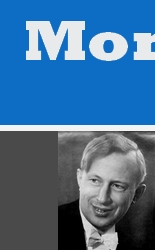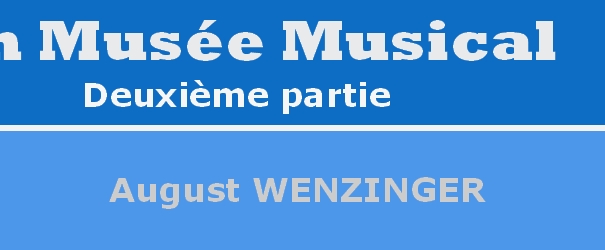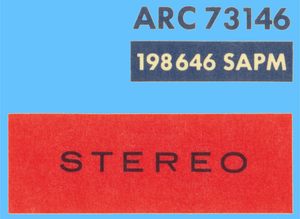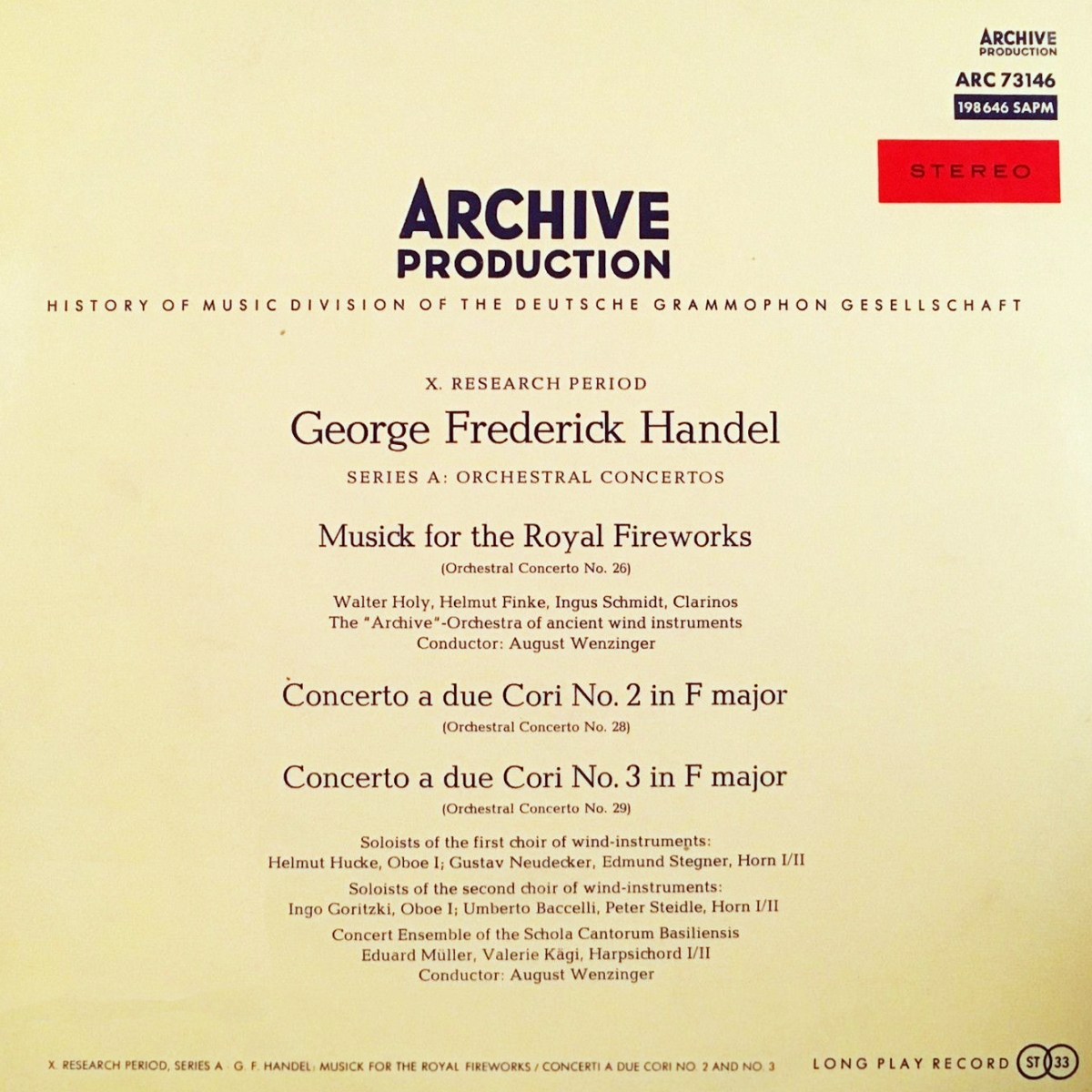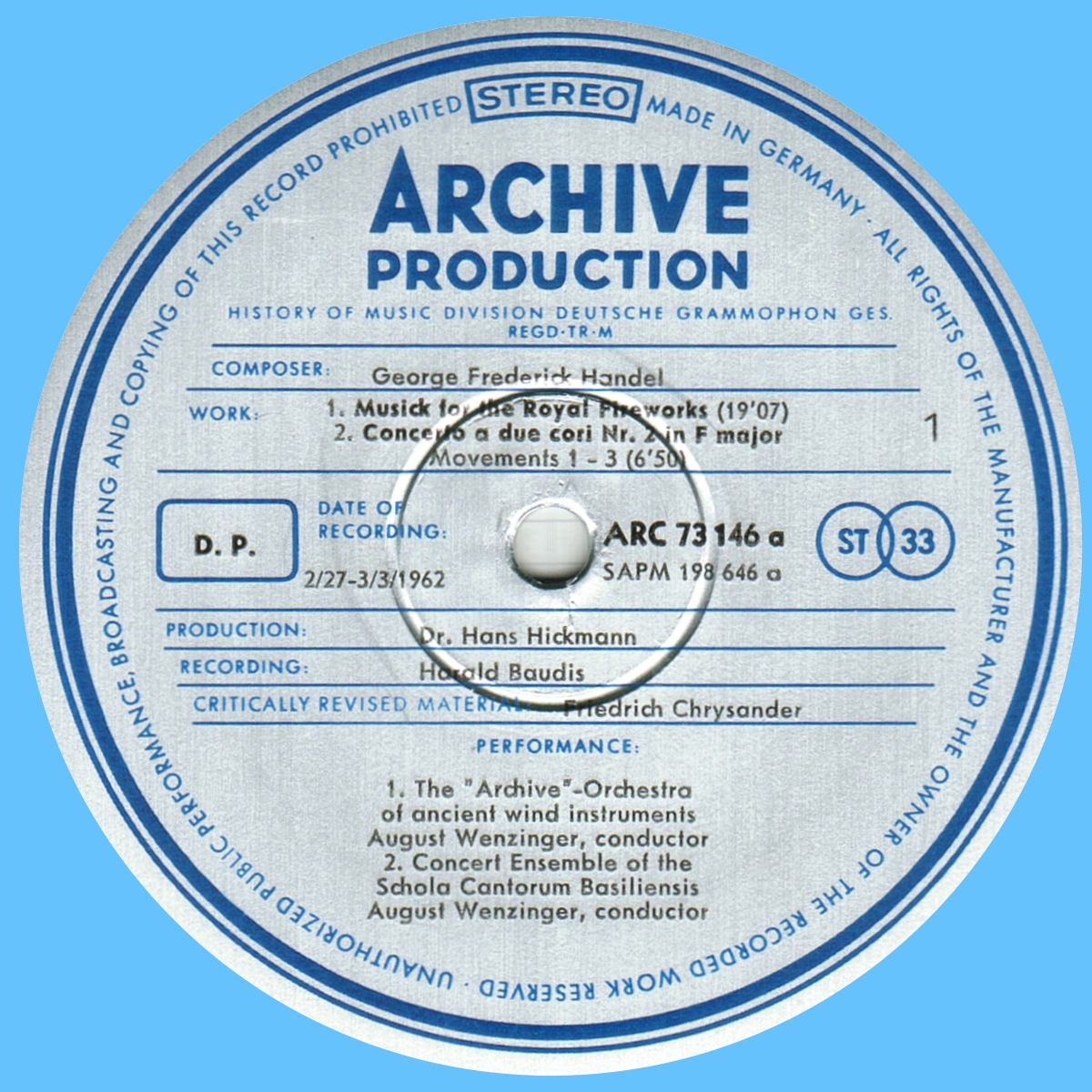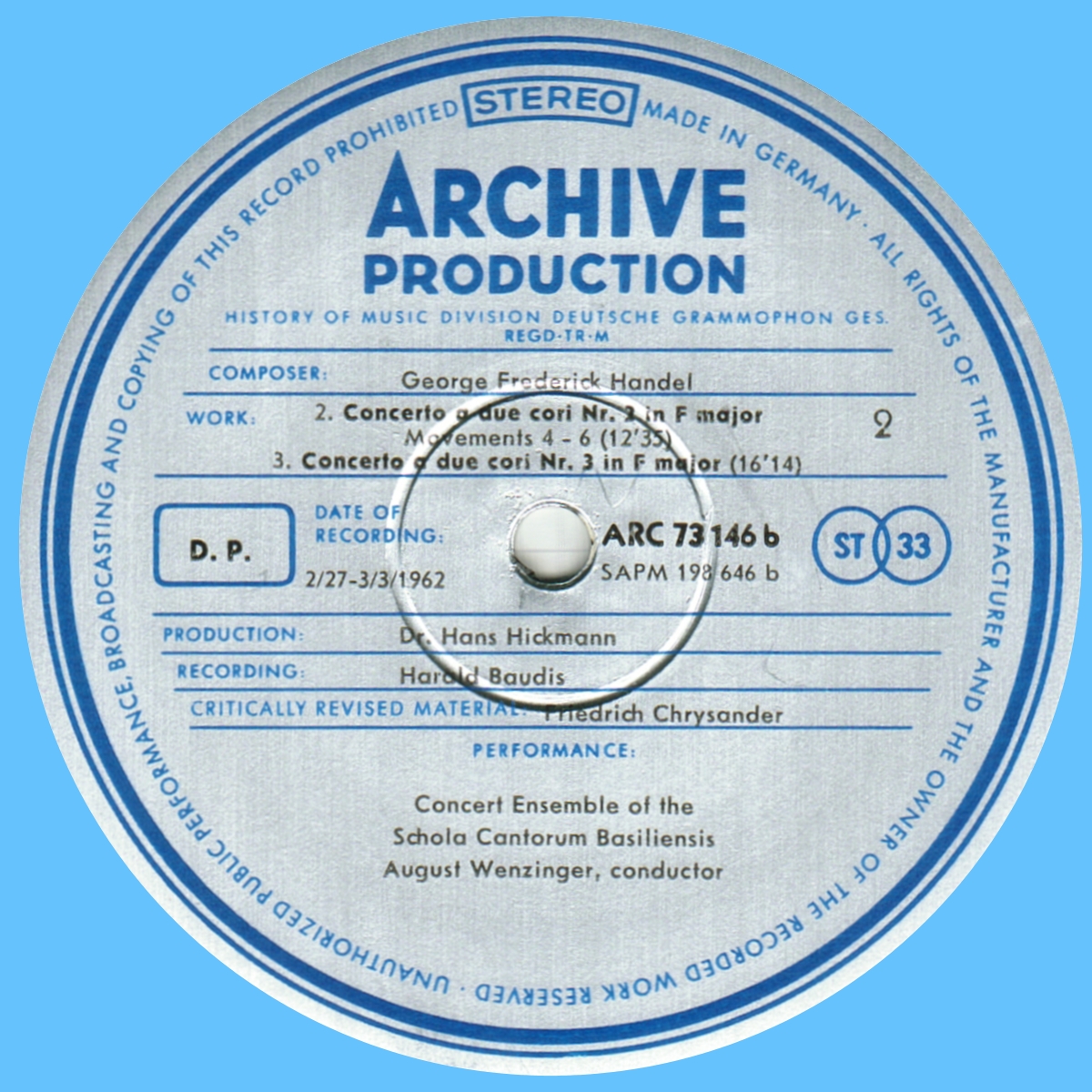Portrait August WENZINGER illustrant l'en-tête de cette rubrique: cité de cette page du site www.bach-cantatas.com, une photo faite par Matthias Hansen
Portrait August WENZINGER à droite: cliquer sur la photo pour vue agrandie et référence
Georg Friedrich HÄNDEL
«The Musick for the Royal Fireworks»
Orchestral Concerto No. 26, HWV 351
Walter HOLY, Helmut FINKE, Ingus SCHMIDT, trompettes
«Archive»-Orchestra of ancient wind instruments
August WENZINGER
27 février - 3 mars 1962
Rudolf-Oetker-Halle, Bielefeld
Deutsche Grammophon Archive Production
ARC 73146 198646 SAPM
«The Musick for the Royal Fireworks» - Musique pour les feux d'artifice royaux -fut composée en 1749 par Georg-Friedrich Haendel pour les festivités en l'honneur du traité d'Aix-la-Chapelle. La représentation officielle du 27 avril 1749 fut marquée par un incendie d'un petit bâtiment du Green Park de Londres, provoqué par le spectacle pyrotechnique.
Au verso de la pochette de ce disque enregistré sous la direction de August Wenziger - DG ARC 73146 198646 SAPM - sont donnés les détails suivants:
"[...] «The Musick for the Royal Fireworks», like the «Water Music» was an occasional composition of Handel. It was ordered by King George II to celebrate the Peace of Aix-la-Chapelle, which was signed on the 7th October 1748, and was performed during the following year, at a great public festivity which took place in Green Park, London, on the 26th April 1749. A few days prior to that, a full-scale rehearsal was held in Vauxhall Gardens, greatly appreciated by some 12'000 spectators. At the celebration itself the firework display was ruined when the building erected for the pyrotechnic exhibition was burned down, so that Handel's music alone saved the day. The master later put this music to the service of charitable causes, performing it again for the benefit of the Foundling Hospital.
The orchestral scoring (for 9 trumpets, 9 horns, 24 oboes, 12 bassoons, 1 contra bassoon and 3 timpani) was dependent on the express desire of the king for an «Overture for military instruments», although Handel originally had in mind a scoring employing wind, strings and continuo. In Chrysander's complete edition of Handel's works there is printed a third version of the work, intended for the concert hall, which omits some of the wind instruments but includes strings. For the present recording the original scoring for wind was employed.
Handel's desire «to avoid the ethos of affected expression» (Adler) in his operas and oratorios to an ever greater extent is clearly evident in this festive work, with its imposing form and contents. Its uncomplicated, popular-style musical language, its impressive pathos and its exemplary melodic beauty indicate the extent to which Handel felt himself personally involved with the national event of the signing of a peace treaty. The Fireworks Music therefore points forward, to a greater extent than almost any other composition, to the humanitarian idealism of Beethoven.
The hymnic splendour of the Overture, with its jubilantly festive Allegro central section, is contrasted by the expressive «Largo alia Siciliana» entitled «La Paix». The lively «Réjouissance», with its fanfare motives, is followed by the Minuets Nos. I and II, which impress both by their dancelike grace and by their courtly dignity. [...]" cité du texte de Günter Schneider publié au verso de la pochette du disque DG Archive Production 198646 SAPM.
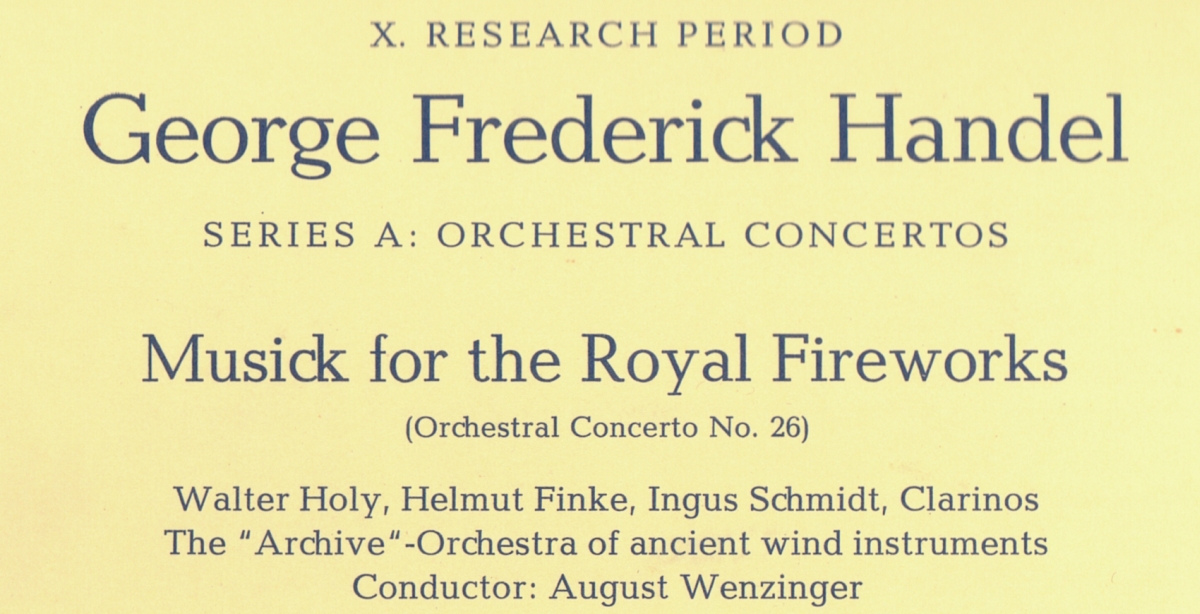
August WENZINGER, le trio de trompettes de la Cappella Coloniensis - Walter HOLY, Helmut FINKE, Ingus SCHMIDT - et un orchestre nommé «Archive-Orchestra of ancient wind instruments» enregistrent cette oeuvre entre le 27 février et le 3 mars 1962, dans la Rudolf-Oetker-Halle de Bielefeld. La première parution eut lieu peu après sur le recto du disque Deutsche Grammophon Archive Production ARC 73146 198646 SAPM, cette face étant complétée par les 3 premiers mouvements du concerto à deux choeurs HWV 333.
Cet enregistrement fut présenté dans la revue «The Gramophone» de décembre 1962, en pages 290-291:
"[...]A roof-raising performance with four hundred strong wind-players is without doubt the proper way to play the Fireworks music (Berlioz, anyway, would have agreed). The resulting sound, reduced in volume to room scale, is approached in this disc; for though the Archive orchestra of ancient wind instruments is not numerous (in this particular somewhat exotic context) it plays strongly, and uses a well-edited version of Handel's score. Strongly is the word, rather than beautifully; the use of antique-style instruments has, of course, its own interest, but it does also have the result of putting any serener quality rather at arm's length, if not exactly out of reach. The principal trumpet (I beg his pardon, clarino) scores a point at the cadence at the end of the Overture's slow introduction; where so many violinists fear to tread he launches into a flourish on his far more intractable instrument. However, either he or the engineers think he has then done his duty for the day; for in the following allegro he retires to near-inaudibility, over-balanced by the second player. Otherwise, save for some very tentative side-drumming in La Rejouissance, the sound is well balanced. It is also rather good, in stereo; but less good, less brilliant, in mono. [...]".
Voici donc...
Georg Friedrich Händel, «The Musick for the Royal Fireworks», Orchestral Concerto No. 26, HWV 351, Walter Holy, Helmut Finke, Ingus Schmidt, clarinos, «Archive»-Orchestra of ancient wind instruments, August Wenzinger, 27 février - 3 mars 1962, Rudolf-Oetker-Halle, Bielefeld, Deutsche Grammophon Archive Production ARC 73146 198646 SAPM
01. Ouverture: (Lentement) - Allegro («La Guerra») 08:16 (-> 08:16)
02. Bouree 01:23 (-> 09:39)
03. Largo Alla Sicilliana («La Paix») 03:46 (-> 13:25)
04. Allegro («La Rejouissance») 02:00 (-> 15:25)
05. Menuets I/II 02:43 (-> 18:08)
Provenance: disque Deutsche Grammophon Archive Production ARC 73146 198646 SAPM
que vous pouvez obtenir en...
5 fichiers FLAC, 2 fichiers CUE (*) et 1 fichier PDF dans 1 fichier ZIP
(*) 1 fichier CUE pour les fichiers décomprimés en WAV et 1 fichier CUE pour les fichiers comprimés FLAC, si votre logiciel peut utiliser directement les fichiers FLAC.
Recto pochette disque DG Archive Production ARC 73146 198646 SAPM
Étiquette recto disque DG Archive Production ARC 73146 198646 SAPM
Étiquette verso disque DG Archive Production ARC 73146 198646 SAPM




